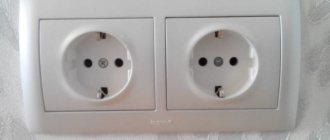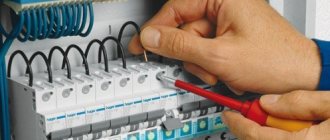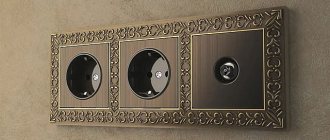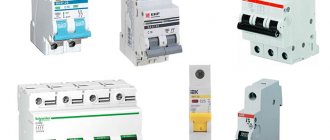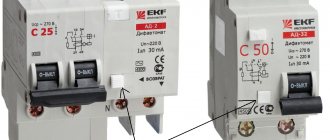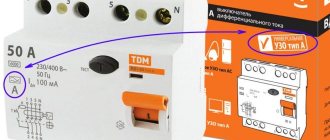When connecting a hob, you may encounter problems that make not only the average user, but also an experienced electrician think:
- which cable to choose for installing electrical wiring from the panel to the hob
- how to connect the panel in the electrical panel
- how to connect 4 wires coming out of the stove and 3 wires of the electrical wiring power cable
- how to connect correctly and not mix up the cable cores on the terminal block
We will consider all these points in detail below. But first, let's decide on possible additional purchases. To connect the hob you will need the following materials:
- cable VVGng-Ls or NYM
- special socket + plug for stoves with current 32A-40A (you can order a similar connector here)
- PVS wire, if no wires are included with the panel
- differential machine
- NShV tips
- terminal block or GML sleeves
What are the benefits of electric stoves?
The main element in the kitchen has always been the stove, because without it the concept of “kitchen” loses its meaning. In gasified houses, gas stoves are mainly used, but recently more and more people prefer electric ones.
Electric stoves are easy to use, do their job well, and are safe, but only if connected correctly.
When purchasing a new electric stove, many stores provide the services of an electrician who makes the connection.
Even if such a service is not provided, sellers strongly recommend using the services of an electrician to connect the device.
And all this because a modern electric stove is a very powerful consumer of electricity, which means that special requirements are placed on the safety of its connection.
But it is not necessary to call a specialist; even with basic knowledge in the field of electrical engineering, it is quite possible to connect this device yourself, there are no particular difficulties in this, but some conditions must be met.
Why doesn't the electric ignition work and what should I do?
Electric ignition device diagram.
Even if this mechanism is assembled perfectly, it can still break someday.
Electric ignition may not work due to:
- Spark plug contamination. This malfunction can be easily fixed without leaving home and without resorting to the help of a specialist. To do this, you need to remove the fat deposits that have accumulated on the candle using a cotton swab dipped in alcohol.
- Power surges that occur on a regular basis.
- Incorrect handling of equipment. For example, you tried to ignite gas when the flame breaker was removed.
Separately, it should be said that in the first and second cases described above, you need to seek the help of a specialist.
Features and conditions of the connection process
The first and one of the most important conditions is the ability of the wiring to withstand significant loads.
The house or apartment must have copper wiring with a cross-section of at least 4 mm. sq. If the power of the stove is significant, then a wire of 6 mm is required. sq. section.
The best option would be to lay a separate line for power supply, which will avoid loading the general wiring of the house, especially if it is an old building and the wiring is not designed for significant loads.
The second condition is the ability of the automatic switchboard to work with significant loads.
Therefore, the wiring that will power the stove should be connected to the circuit breaker with the highest current value, or an additional powerful circuit breaker should be installed under it in the distribution panel.
In this case, the current value of the machine should be one rating higher than this parameter of the plate in order to avoid critical loads. That is, when connecting a device with a current consumption of 20 A, a 25 A machine is used.
The third condition is the availability of additional means of protection. They can be differential circuit breakers or a residual current device.
The last condition is the correct connection. The stove can be connected to an outlet, which provides some convenience, allowing you to turn it off at any time.
But the socket and plug must be powerful and capable of operating under loads.
We carry out grounding
The need for grounding is explained by the high power of kitchen electrical appliances. Its implementation is possible, firstly, by using the existing general grounding of the dwelling structure. For this purpose, you should contact the Housing Office to confirm information about connecting the distribution panel of your own square meters to the house grounding.
When confirming this information, the earth electrical wire must be connected to the distribution board grounding , which is the thickest electrical wire, which in turn is connected to the panel housing with a bolt.
If there is no house grounding in your own home or if the apartment is located on the ground floor, grounding can be equipped independently. To do this, three rods are driven into the ground, connected by a metal strip to which a steel wire is attached. Its installation is carried out in the house, where the earth's electrical wire is connected.
Source: housetronic.ru
Security measures
When connecting, it is important to take security measures seriously. The wiring, socket with plug or terminal block must be designed to withstand significant loads.
The most important thing is to choose the right cable cross-section.
All connections must be well tightened; loose loose bolts or screws when connecting wiring are not allowed.
It is also important not to confuse the wiring when connecting to the stove, socket, RCD plug and machine.
Let's summarize.
In order for the electric stove to operate with maximum safety, it is necessary to ensure the supply of electricity to it with the appropriate parameters - the wiring, socket and circuit breaker must withstand a load greater than that created by the electric stove, but the RCD in terms of current strength must be as close as possible to this parameter of the electrical appliance. And it’s better if a separate line and automatic machine are used to power the electric stove.
But compliance with the conditions is not enough; you still need to connect the wiring correctly. After all, stoves can operate from a single-phase or three-phase network; there are also two-phase stoves, and it is important to connect everything correctly.
Choosing the power of a new hob
For any cooking equipment, power is considered the main indicator. This criterion determines how long the food will take to cook on the stove and how convenient it will be for the housewife to work with the electric surface. It’s good when the burner heats up in just a couple of seconds and cools down just as quickly. But this convenience also has a disadvantage - high energy consumption.
Electric
A hob for connection with 4 burners is in demand. Manufacturers have equipped the device with heating points of different power:
- 1 conf. − 0.4-1 kW.
- 2nd conf. – 1.5 kW.
- 4 conf. – up to 3 kW.
The total is 7 kW.
| Advice! There are units on the market with additional options, such as adjusting the overall heating level for each point, with a large number of points, for non-standard shaped dishes, etc. the total power can increase to 10 kW. |
Induction
This is the most modern type of equipment for heating food in the kitchen. The average power of such a surface is 7 kW. But we are talking about the consolidated power of technology.
Gas
Natural fuel is not electricity, so it is impossible to measure the amount of energy consumed or received. You can take into account the amount of gas passing through the electric meter. The calorific value of gas is 8-11 W per hour/m3. The quality of fuel in the kitchen can be assessed subjectively.
But you can rely on the following indicators:
- Approximately capacity 1 conf. is 2-2.5 kW.
- At 4 conf. indicator 8-10 kW.
Reduced power of individual conf. compensated by the heat output of the largest burner. The higher the diameter of the burner, the greater the power.
Connection to a single-phase network
In the electric stove, under the protective cover, there are contacts to which the wire is connected.
For a single-phase network, this cable must be three-core.
One core is phase, the second is zero, the third is grounding. In the cable, each core has its own color. It is important to remember that the neutral wire is always blue or light blue, and the ground wire is yellow-green.
In the plate, there are usually more contacts for connection, but each of them has its own designation.
All terminals marked with the letter “L” are phase, no matter how many there are, zero is marked with the letter “N”, there may also be several of them, grounding is indicated with the letters “PE”, usually this is one terminal.
Knowing this, you can easily connect the cable. If, for example, there are several “L” terminals, and there is only one phase in a single-phase network, then you need to use the jumpers that come with the stove.
First, we connect the ground wire to the “PE” terminal, then the zero wire to the “N” terminal.
If there are several such pins, we use a jumper, connecting them together, and then connect the blue wire to one of the pins.
The last phase is connected. We connect all the pins marked with the letter “L” with a jumper (if there are three of them, then they are designated as “L1” “L2” “L3”).
After connection, connect the phase wire. In a three-core cable, it may be brown, gray or black.
Skewer
When using a spit, you need to be extremely careful. Its rod and forks have sharp ends, so there is a risk of injury. It is necessary to insert the holder hook into the hole located in the upper part of the cabinet. Place the first fork on the spit, then thread the meat onto it and insert the second fork. Then you should tighten the plugs using the screws. Place the front part of the spit on the hook of the holder and remove the handle. Place a baking sheet on the very bottom and turn the mode control knob. It should be borne in mind that you can cook products on a spit with a weight not exceeding 5 kg.
Connection to a two-phase network
A rare, but still common connection method.
The connection diagram for an electric stove operating from a two-phase network is somewhat different, since this requires a cable with 4 cores, two of which will be phases, the other two will be zero and ground.
The connection is made as follows: connect the ground wire, then use a jumper for the zero terminals and connect the neutral wire.
If the plate has three phase terminals, then connect two of them with a jumper and connect one phase wire to one of the terminals, and the second phase wire to the remaining third terminal.
Connection to a three-phase network
To connect a stove operating from a three-phase network, you need a cable with 5 cores, 3 of which will be phases, the other two - ground and zero.
Again, first connect the ground and zero, having previously shorted the zero terminals with a jumper, if there are several of them.
We connect one phase wire to the three phase terminals.
The colors of the phase wires may be different, but it is important to remember that the neutral wire is always blue or light blue, and the ground wire is yellow-green.
Keeping this in mind, you can easily connect the cable to the stove, and it does not matter what network it is on.
The most preferred type of oven
Which oven to choose depends only on your preferences.
What you should pay attention to when choosing:
- Gas ovens are more economical to use, but not as safe. When gas burns, many harmful substances will be released into the air, and if used intensively without proper ventilation of the room, this can affect the health of family members.
- Electric ovens will consume a lot of electricity, but will delight you with functionality. Here you can choose the modes of upper or lower heating, convection, grill, and reheating. And flexible temperature settings will allow you to cook even “capricious” sponge cakes.
Complete connection diagram via socket
Now let’s look at the complete connection diagram for an electric stove; for example, let’s take a model operating from a 220 V network (single-phase), and we’ll lay a separate line for it.
First, let's connect it using a socket. Before starting work, the switchboard must be de-energized.
So, first of all, we connect the wire to the machine on the distribution panel.
We connect the phase and neutral wires to it, the ground should be connected to the grounding of the house or apartment.
Regarding grounding - a little lower. Immediately behind the machine we connect the RCD in series and secure it.
Then the wire is pulled to the location where the socket is installed. This can be done in an open way (using a corrugated tube or plastic box).
Read more here: How to properly install electrical wiring.
The socket and plug for a single-phase network must be three-pin.
When connecting wires to an outlet, be careful not to tangle the wires. The earth must be connected to the ground contact, the zero to the zero contact, and the phase to the phase contact.
And you definitely need to make sure that the cable from the stove is connected to the plug in the appropriate way. It is very important not to confuse the wiring.
We fix the socket on the wall, it is important that it is located at a distance from metal structures (pipes or radiators), that it is not affected by heat sources, and that water does not enter.
Then we connect the power cable along with the plug to the stove. After this, we carefully check all connections, they must be well tightened, all elements of the circuit must be securely fastened.
Next, a trial run is carried out. First, the machine turns on, then the RCD, and the stove itself.
After turning on the stove at full power, everything is turned off and all elements are checked for heating.
How to connect an electric stove yourself
The general principle of connecting an electric stove to the network is no different from connecting any other electrical appliance, but its increased energy consumption imposes certain requirements on the type of connection, so many often doubt how best to do it correctly.
Let's look at all the most common methods of connecting electric stoves, most often found in our kitchens, so that when necessary, you can complete the installation yourself.
Connection without socket
Connecting a stove without using an outlet, but using a terminal block, is practically no different.
The wire is connected to the machine, then it cuts into the RCD circuit, and the wire is pulled to the installation site of the stove.
A recess is made in the wall into which a protective box is installed. The terminal block is placed in this box.
The wire coming from the distribution panel, as well as the cable from the stove, is supplied and connected to it.
They are fixed in the terminal block; it is important not to confuse which wire is which.
After this, the protective box is closed with a lid. Well, then – a performance check.
It is noteworthy that the connection diagram for electric stoves is almost the same.
Many people are familiar with Hansa and Mechta electric stoves. Buyers often ask how to connect them correctly.
Since there are many models of stoves, it is difficult to guess which one you purchased. But we described all possible connection methods above.
See the power consumption and what wiring your model is designed for (single-phase, two-phase or three-phase) and apply our recommendations.
The Hansa stove from a foreign manufacturer is connected to the network, just like the domestic Mechta stove. It is only important to choose the right wiring and all other elements included in the power line.
Popular among readers: Methods for replacing electrics in an apartment.
Preparatory activities
What supplies and consumables you will need will become clear as the story progresses. Therefore, there is no point in dwelling on such “little things” as screwdrivers, a probe, and the like. Any electrical installation work involves the use of a certain set of household tools.
Inspection of the power shield
First of all, you need to check what maximum current the input machine is designed for. The value is within 45±5 A - everything is in order; this is usually sufficient. But if it’s less, you’ll have to replace it.
Recommendation - in private houses, as a rule, there are more rooms than in an apartment. Naturally, if you have money and free space, cottages are not “equipped” with household appliances like they are. There are quite a lot of products. It is recommended not to be lazy and calculate the total power consumed by them, and then add an electric stove. Will it hold up? Practice shows that it can be regularly “knocked out”. This mostly applies to purchased houses. It is not a fact that the new owner knows thoroughly what and how the previous owner installed in the panel.
Availability of grounding
This applies to apartment owners, since cottage owners do not face this problem.
Recommendation - it is better not to delve into this issue yourself, but to invite an electrician from the housing department. Why? Only he knows what circuit the house is connected to. If this is a TN-C system, then “surprises” are possible, since operating independently in such an access panel often leads to emergency situations. One of the common ones is the so-called zero burnout. The consequences are easy to predict, including for the wallet of the owner of the electric stove.
